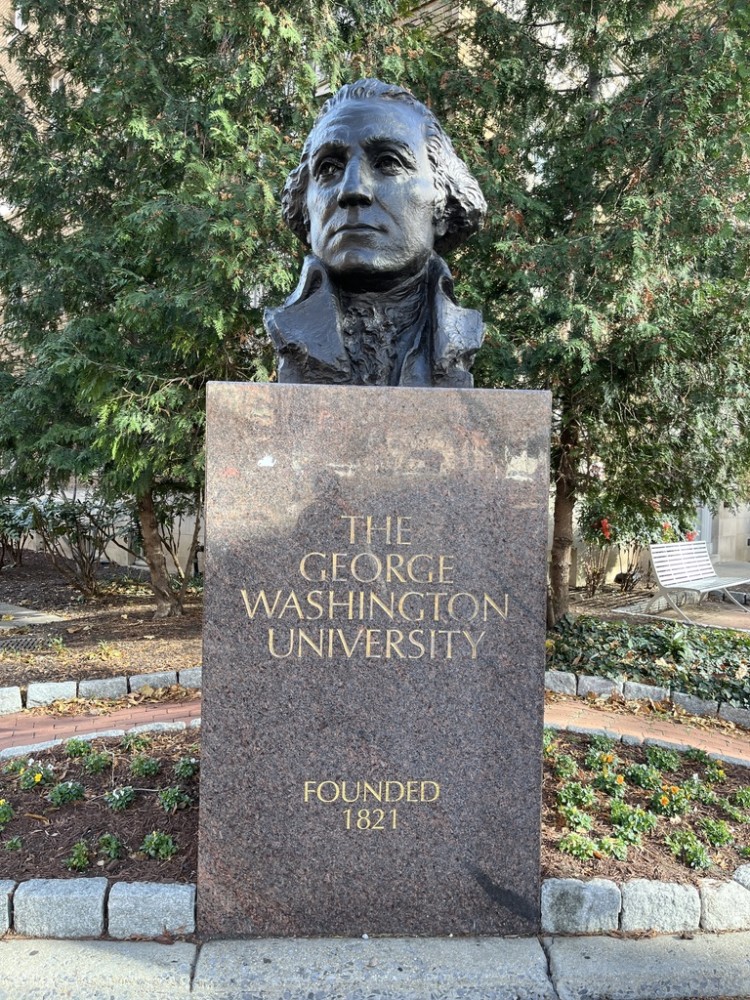George Washington U. embraces D.C. locale
Fast facts for
George Washington University

The George Washington University takes full advantage of being at the center of Washington, D.C., the seat of the U.S. government and also a hub for business, health, and technology. The 10,500 residential undergraduates join 11,000 graduate students and 2,400 medical and law students on an urban campus just four blocks from the White House.
Choose urban or suburban home
Most of the action happens on the downtown Foggy Bottom campus, but a second campus, known as Mount Vernon (not the one the first president occupied) offers a more traditional campus for students who want that experience. A 10-minute shuttle ride connects the two campuses, just 3 miles apart, and 700 students call Mount Vernon home. They get a smaller-college experience but all the resources of a larger university.
Meeting full demonstrated need
George Washington’s cost of attendance is $92,000, but they will meet full demonstrated need and have merit scholarships for up to full tuition. Fill out both the FAFSA and the CSS Profile. They are trying to eliminate pay-to-play impediments to participating in internships. The UPass gives GWU (and American University) students free rides on the Metro subway system and buses, so internships, which are plentiful, are easy to access. Giving Tuesday donations went toward funds for internships.
GW is steady, consistent with 20-year development plan
All freshmen are on the unlimited meal plan plus dining dollars that can be used outside the dining halls. Before 2022, GWU students relied on dining dollars used at restaurants, but the administration found that having central dining halls helped to build community.
GWU has a 20-year development plan. They are not looking to grow their enrollment, only to improve the campus and provide excellent academics. Ben Toll, the dean of undergraduate admissions, told counselors on December 6 that they want to be known as steady and consistent. The school is popular along the Acela corridor (D.C. to Boston), but they are looking to do more recruiting in their backyard of the DMV (D.C., Maryland, Virginia). About 12% of students come from outside the U.S.
For the class arriving in 2024, GW had 27,000 applicants and an acceptance rate of 44%. This year, 200 students were accepted off the waitlist. However, Toll cautioned that the waitlist can vary wildly year to year.
Applying to GW
George Washington went test-optional in 2015 and has no plans to reinstate a testing requirement. Their data showed that GPA predicted success better than standardized test scores. This past year, GW experienced an all-time high in retention and graduation rates.
When you apply to GW as an undergrad, you apply to one of their schools:
- Columbian College of Arts and Sciences
- Corcoran School Art and Design
- School of Public Policy and Public Administration
- School of Media and Public Affairs
- School of Business
- School of Engineering and Applied Science
- School of International Affairs
- School of Nursing
- School of Public Health
Once you’ve applied, make sure to continue checking your portal and your email. GW will send you an email showing six key decisions that you have to make. And don’t worry if you indicated you don’t want to apply for financial aid and then realized you should have. If you change your mind about something, you have two weeks post-submission to change your answers. But check those emails!
Noteworthy programs
- Biomedical Engineering
- Business Analytics
- Business Economics and Public Policy (concentration within business)
- Cognitive Neuroscience
- Health Data Science
- International Affairs
- Nutrition with concentration in pre-med
- Political Communication
- Psychological and Brain Sciences
Fill out FAFSA, CSS Profile
Tony Sutphin, from GW’s financial aid office, spoke to counselors about the financial aid process. According to Sutphin, everyone should fill out the FAFSA and CSS Profile. Some scholarships and donors require financial disclosure. He said there’s $10 million available and families can be leaving money on the table by not filling out the forms.